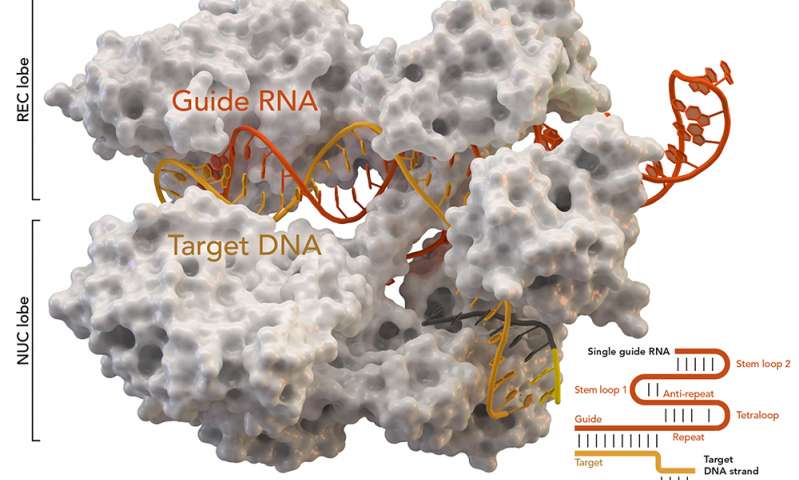Heidi Ledford’s June 25, 2020 article (Note: Links have been removed) for Nature focuses on three studies (not yet peer-reviewed) that viewed together suggest CRISPR (clustered regularly interspaced short palindromic repeats) gene-editing is less like using a pair of scissors to cut out unwanted mutations and more like using a catalyst (a chemical agent which increases chemical reactions) and getting unanticipated and unwatned reactions. Except, it’s an unpredictable catalyst.
A suite of experiments that use the gene-editing tool CRISPR–Cas9 to modify human embryos have revealed how the process can make large, unwanted changes to the genome at or near the target site. [emphasis mine]
The studies were published this month on the preprint server bioRxiv, and have not yet been peer-reviewed1,2,3. But taken together, they give scientists a good look at what some say is an underappreciated risk of CRISPR–Cas9 editing. Previous experiments have revealed that the tool can make ‘off target’ gene mutations far from the target site, but the nearby changes identified in the latest studies can be missed by standard assessment methods.
…
These safety concerns are likely to inform the ongoing debate over whether scientists should edit human embryos to prevent genetic diseases — a process that is controversial because it creates a permanent change to the genome that can be passed down for generations. “If human embryo editing for reproductive purposes or germline editing were space flight, the new data are the equivalent of having the rocket explode at the launch pad before take-off,” says Fyodor Urnov, who studies genome editing at the University of California, Berkeley, but was not involved in any of the latest research.
…
These studies,if borne out, offer new concerns (from Ledford’s June 25, 2020 article),
The changes are the result of DNA-repair processes harnessed by genome-editing tools. CRISPR–Cas9 uses a small strand of RNA to direct the Cas9 enzyme to a site in the genome with a similar sequence. The enzyme then cuts both strands of DNA at that site, and the cell’s repair systems heal the gap.
The edits occur during that repair: most often, the cell seals up the cut using an error-prone mechanism that can insert or delete a small number of DNA letters. If researchers provide a DNA template, the cell might sometimes use that sequence to mend the cut, resulting in a true rewrite. But broken DNA can also cause shuffling or loss of a large region of the chromosome.
Previous work using CRISPR in mouse embryos and other kinds of human cell had already demonstrated that editing chromosomes can cause large, unwanted effects4,5. But it was important to demonstrate the work in human embryos as well, says Urnov, because different cell types might respond to genome editing differently.
Such rearrangements could be missed in many experiments, which typically look for other unwanted edits, such as single DNA-letter changes or small insertions or deletions of only a few letters. The latest studies, however, looked specifically for large deletions and chromosomal rearrangements near the target site. [emphasis mine] “This is something that all of us in the scientific community will, starting immediately, take more seriously than we already have,” says Urnov. “This is not a one-time fluke.”
…
Ledford’s article offers some description and analysis of each of the three papers.Note: All of the research was done with nonviable embryos. For anyone who wants to read the papers for themselves here are links and citations for each of the three,
Frequent loss-of-heterozygosity in CRISPR-Cas9-edited early human embryos by Gregorio Alanis-Lobato, Jasmin Zohren, Afshan McCarthy, Norah M.E. Fogarty, Nada Kubikova, Emily Hardman, Maria Greco, Dagan Wells, James M.A. Turner, Kathy K. Niakan. bioRxiv DOI: https://doi.org/10.1101/2020.06.05.135913 Posted: June 5, 2020
Reading frame restoration at the EYS locus, and allele-specific chromosome removal after Cas9 cleavage in human embryos by Michael V. Zuccaro, Jia Xu, Carl Mitchell, Diego Marin, Raymond Zimmerman, Bhavini Rana, Everett Weinstein, Rebeca T. King, Morgan Smith, Stephen H. Tsang, Robin Goland, Maria Jasin, Rogerio Lobo, Nathan Treff, Dieter Egli. bioRxiv DOI: https://doi.org/10.1101/2020.06.17.149237 Posted June 18, 2020
FREQUENT GENE CONVERSION IN HUMAN EMBRYOS INDUCED BY DOUBLE STRAND BREAKS by Dan Liang, Nuria Marti Gutierrez, Tailai Chen, Yeonmi Lee, Sang-Wook Park, Hong Ma, Amy Koski, Riffat Ahmed, Hayley Darby, Ying Li, Crystal Van Dyken, Aleksei Mikhalchenko, Thanasup Gonmanee, Tomonari Hayama, Han Zhao, Keliang Wu, Jingye Zhang, Zhenzhen Hou, Jumi Park, Chong-Jai Kim, Jianhui Gong, Yilin Yuan, Ying Gu, Yue Shen, Susan B. Olson, Hui Yang, David Battaglia, Thomas O’Leary, Sacha A. Krieg, David M. Lee, Diana H. Wu, P. Barton Duell, Sanjiv Kaul, Jin-Soo Kim, Stephen B. Heitner, Eunju Kang, Zi-Jiang Chen, Paula Amato, Shoukhrat Mitalipov. bioRxiv DOI: https://doi.org/10.1101/2020.06.19.162214 Posted June 20, 2020
These papers are open access.
A July 17, 2018 posting is probably the first time I featured work showing that CRISPR gene-editing can result in off-target effects; it was followed up by a September 20, 2019 posting on the topic.
